The Beginner's Guide To Grammar翻译。每天翻译一点儿,学习加锻炼。
Hello there!
If you ever feel dread when you hear the word grammar, I understand. I used to feel the same way. For years, I thought that grammar was confusing and boring. I thought that I wasn’t smart enough to “get” it – a self-limiting belief that stayed
with me through most of college, where I was studying to become a teacher.
你们好啊!
假如你曾一听见语法这个词就感觉恐惧,我能理解。我过去有相同的感觉。那些年,我认为语法既令人困惑又无聊。我觉得我没那么聪明能去弄懂它-我在大学里进修教师专业的时候,自我限制的思维伴随我度过整个大学生涯。
I was lucky enough to have a couple of amazing teachers later in my life,and they helped me understand grammar.I suddenly felt like I could conquer the world!
在我之后的人生里,我很幸运地拥有了一群很棒的老师帮助我理解语法。突然间,我觉得我能征服这个世界!
I started teaching my students using the same techniques that helped me,and they loved it! Once I saw how much they were learing and how much they enjoy themselves, I realized how painless - and even fun - grammar could be.
我开始教授我的学生们使用那曾帮助过我的相同的技巧,然后学生们也热爱这种方法!当我看见他们沉醉于学习并享受时,我意识到语法学习能变得多么的轻松甚至是愉快。
My goal with Grammer Revolution is to open you up to the joy of understanding how language works. I want to turn your dread into confidence and your boredom into fascination. I want to help you love language.
我的语法革命目标是开发你对理解语言如何运作的乐趣。我想要使你的恐惧变成自信,乏味变成着迷。我想帮你爱上语言。
I hope that you enjoy this guide and that it inspires you to learn more about grammar and sentence diagramming.
我希望你享受这个指南并且这个指南能鼓舞你学习更多关于语法和句子结构图解的知识。
Welcome to the Grammar Revolution!
欢迎来到语法革命!
Happy learning
快乐学习吧
The Parts Of Speech 词性
Let's get started! Did you know that we can categorize the words that we use into eight groups called the parts of speech?
让我们开始吧!你知道我们能将我们使用的单词分为8个词性类吗?
Just think about that fact for a minute.We use thousands, and they can all be separted into just eight groups! Isn't tat the coolest thing ever?
用几分钟时间思考下这件事。我们使用成千上万的单词,但这些单词却能被分为仅仅8类!那不是件最酷的事吗?
- Nouns 名词
- Pronouns 代词
- Verbs 动词
- Adjectives 形容词
- Adverbs 副词
- Prepositions 介词
- Conjunctions 连词
- Interjections 感叹词
Many words can function as multiple parts of speech.(Find this video at the bottom of the linked page.)
许多单词有多种词性。(通过底部的链接观看视频)
http://www.GrammarRevolution.com/parts-of-speech.html
For your learning pleasure, I've listed all eight parts of speech in this handy little guide.
为了你的学习愉快,我已经用这个便利小巧的指南列举了所有的词性。
You'll find a brief definition,a few examples, and a sentence diagram for each one. Are you familiar with sentence diagrams?
你将会看到一个包含一些例子的简短的介绍和每个的句子结构图解。你熟悉句子结构图解吗?
They are pictures of sentences. They are made up of lines and words, and they show us how each word in a sentence is related to the other words.
它们是些句子图片。它们有线条和单词组成,它们像我们展示了在句中的每个单词与其他单词间的联系。
Sentences are simpler than you think!
句子比你想象的要简单!
http://www.GrammarRevolution.com/sentence-construction.html
RELAX 放松
Remember that this is a beginner's guide and my goal is to give you a big-picture understanding of these categories.Do not fret about having a perfect understanding of all of this information. This is especially true if you're new to studying grammar and sentence diagramming. Just take in whatever you can. I can feel you getting smarter already.
记住这是个初学者指南,并且我的目标是给你一个理解这些种类的大方向。不要因为追求完美地理解这个信息的所有内容而苦恼。尤其是假如你是刚开始学习语法和句子结构图。仅仅掌握你能掌握的。我就能感受到你已经变得更聪明了。
1.Nouns name people,places,things, or ideas. 名词 人名,地点,事物,或者概念
Examples: Maria,office,sunlight,happiness
举例:Maria,咖啡,阳光,快乐
- The fish swam throufh the water in the pond.
鱼儿在池塘的水中游泳。 - A peacock walked through our yard.
一个雄孔雀走过我们的院子。
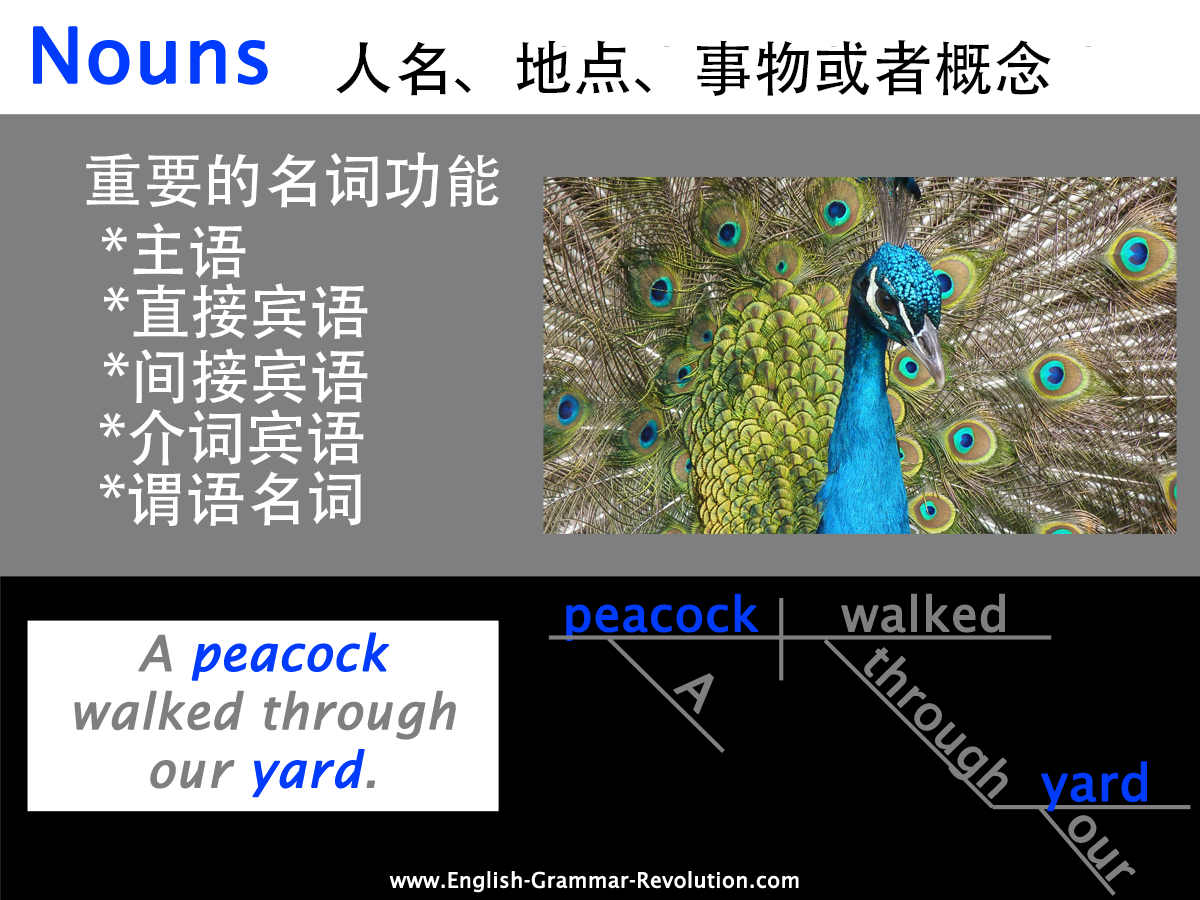
Sentence diagrams show us the jobs that words perform.As you can see in the following sentence diagram, nouns can perform many jobs.(You'll see the word noun where nouns can go.)
句子结构图解像我们展示了单词承担的功能。因此你可以在下面的句子结构图解中看见,名词可以有许多作用。

Not every sentence will have all of these nouns, but every sentence will have at least a subject.(The subject tells us whom or what a sentence is about.)
并不是每个句子都会有所有的这些名词,但是每个句子会有至少一个主语。(主语告诉我们一个句子是有关什么人或事物的。)
Remember! Do not let your head explode!
记住!别把你的脑袋想炸了!
2.Pronouns take the place of one or more nouns. 代词 替代一个或多个名词
Examples:I,you,me,they,who,ypurself
- Would you like to go with me to the beach?
你想和我去沙滩吗? - We walked across the bridge.
我们走过了这座桥。
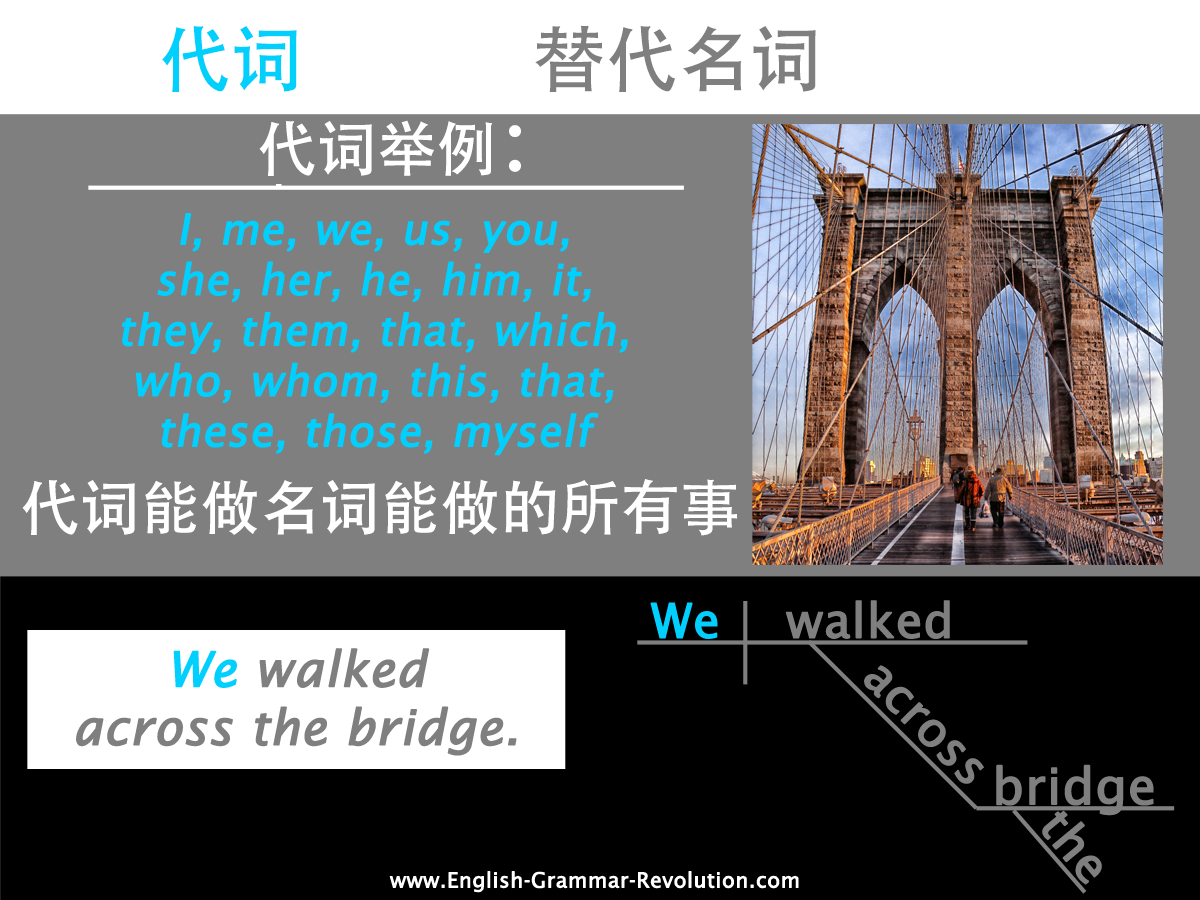
Since pronouns take the place of nouns, they can perform all of the same jobs that nouns perform! Pronouns can fit into any of the slots that say noun.
代词代替名词后,它们能起到所有名词能起到的作用!代词能放在任何一个表示名词的地方。

3.Verbs express actions or states of being. 动词 表示动作或者状态
Examples: eat, find, run, walk, become, feel, seem, are
举例:eat, find, run, walk, become, feel, seem, are
- The shuttle flew into space.
航天飞机飞向太空。 - He is president.
他是主席。
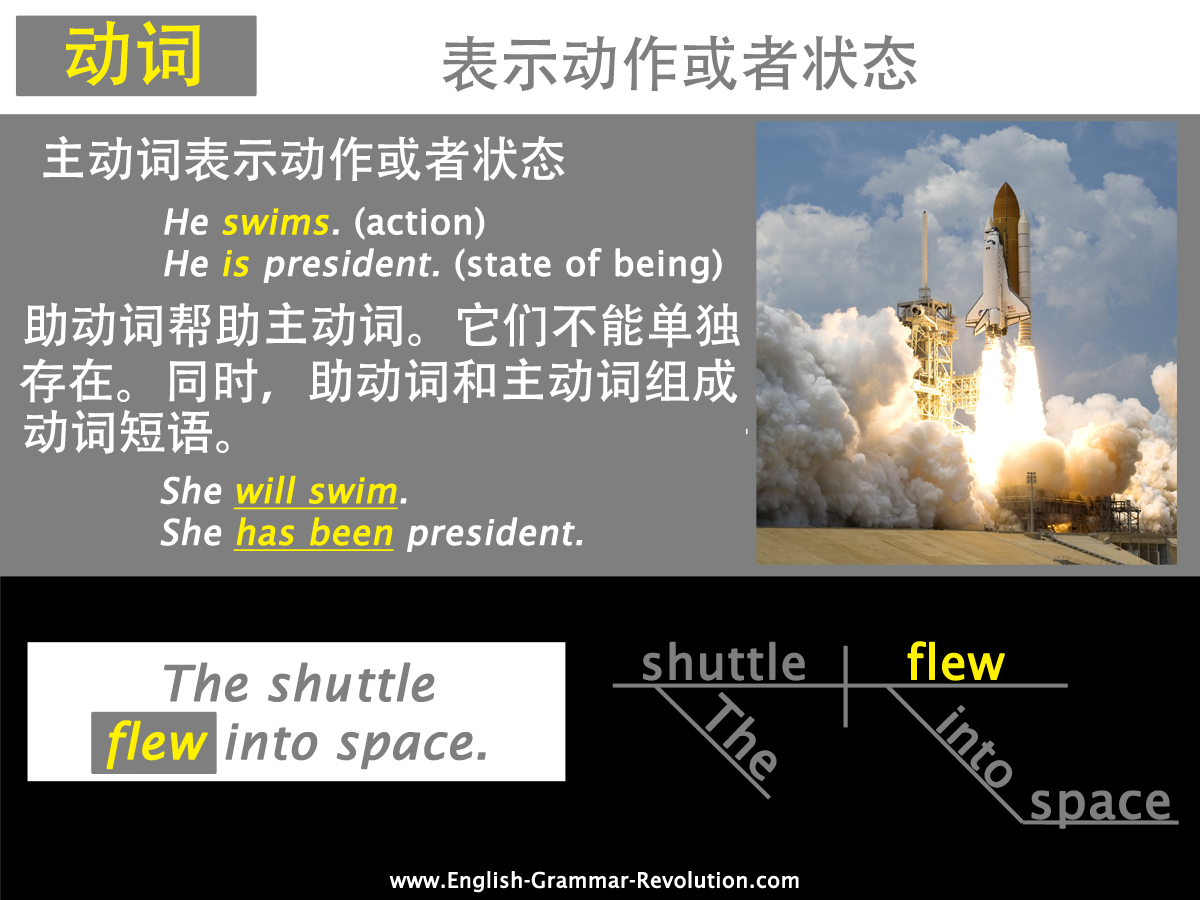
Every sentence needs to have a verb. It tells us what the subject is being or doing.
每个句子需要一个动词。它告诉我们主语的状态或主语干了什么。
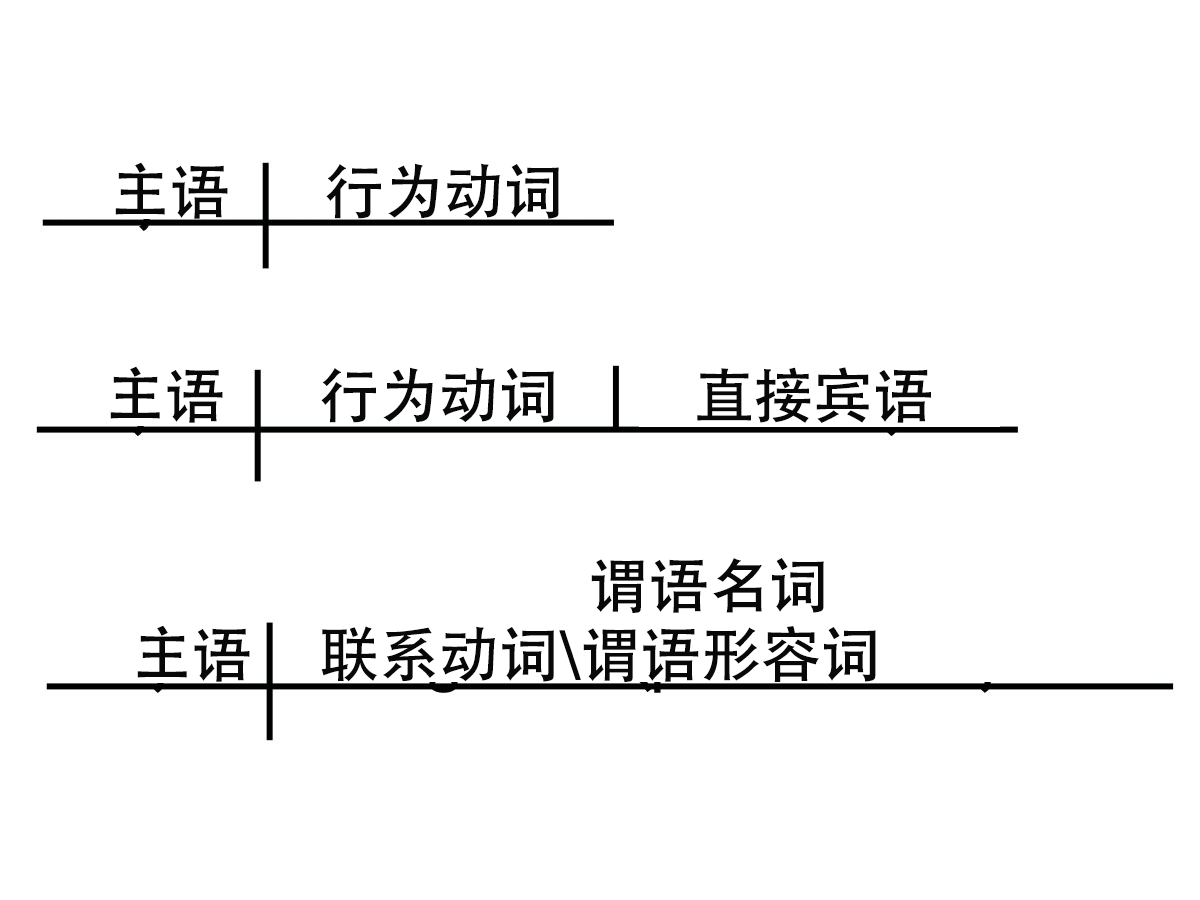
4.Adjectives describe - or modify - nouns and pronouns. 形容词 描述或修饰名词和代词。
Examples: the, orange,special, many, Charlie's
举例:the, orange,special, many, Charlie's
Seven swans swam across the lake in front of Jane's house
七只天鹅游过在简的房子前的湖。The wise, handsome owl had orange eyes.
智慧帅气的猫头鹰有着橘色的眼睛。
Adjectives answer certain questions that we call the adjective questions.
形容词回答确定的问题我们叫这为形容词问题。
- Which one?(Which owl?the wise, handsome owl)
哪一个?(哪个猫头鹰?聪明帅气的猫头鹰) - What kind?(What kind of eyes? orange eyes)
哪种?(哪种眼睛?橘色的眼睛) - How many?(How many swans? seven swans)
多少?(多少天鹅?7只) - Whose?(Whose house? Jane's house)
谁的?(谁的房子?简的房子)
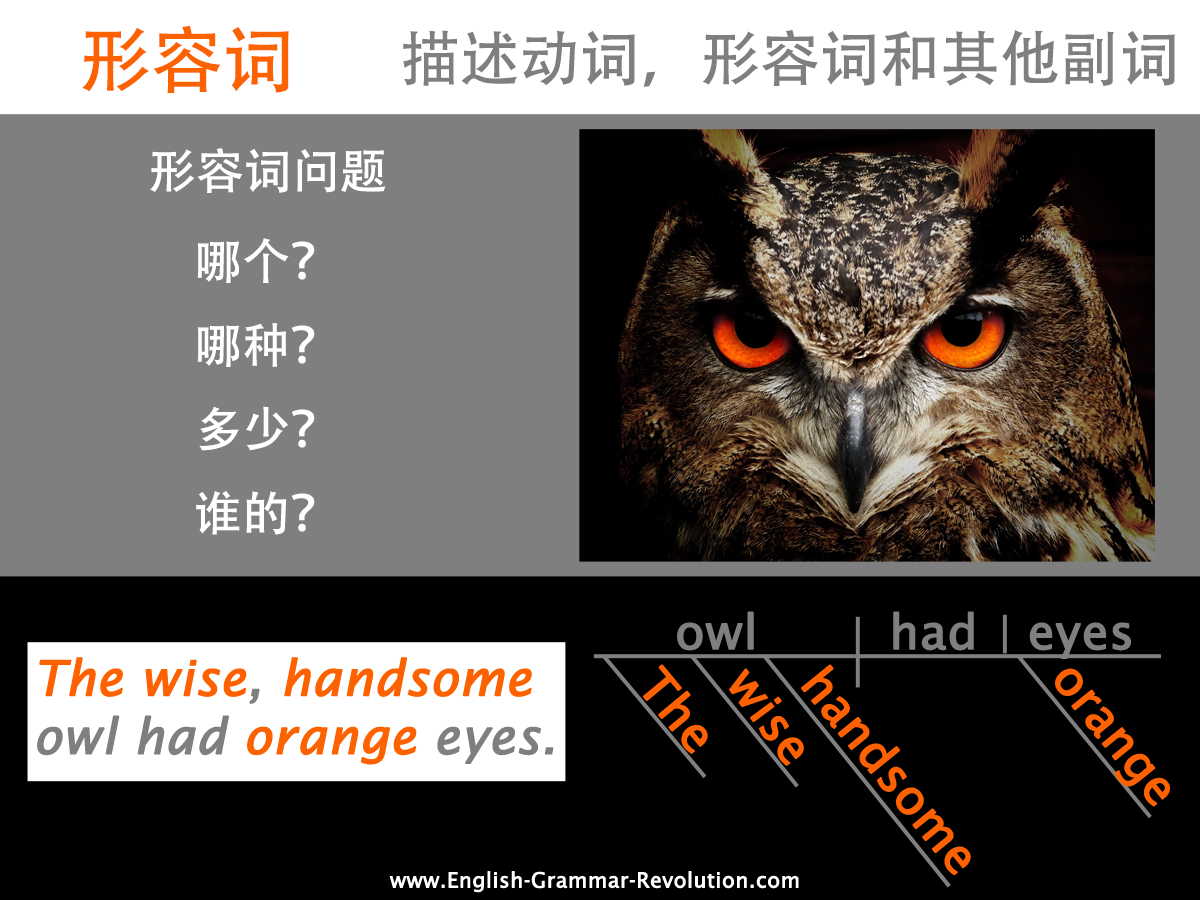
Since adjectives describe nouns and pronous, we diagram them on diagonal lines coming off of the noun or pronoun that they are describing. Isn't that neat?
因为形容词描述名词和代词,所以我们用斜线在被修饰的名词或代词前引入形容词。那不是很整洁吗?

5.Adverbs describe verbs,adjectives, and other adverbs. 副词 描述动词,形容词和其他副词
Examples:quickly, silently, well, yesterday, very, so
举例:quickly, silently, well, yesterday, very, so
- Yesterday, we shopped everywhere!
昨天,我们到处购物! - The extremely cute koala hugged its mom very tightly.
非常讨人喜欢的考拉非常紧的挂在它妈妈身上。
Adverbs answer certain questions that we call the adverb questions.
副词回答了我们称作副词问题的问题。
- How?(How did the koala hug its mom? tightly)
怎样?(考拉怎样挂在它妈妈身上? 紧紧地) - When?(When did you shop? yesterday)
什么时候?(你什么时候去购物的? 昨天) - To what exent?(To what exent did the koala hug tightly? very)
到什么程度了?(这考拉紧紧地挂着到了什么程度? 非常) - Why?(Adverbs that answer this question are typically made up of more than one word.Example: I shopped because I needed new shoes.)
为什么?(回答问题的副词通常由超过一个单词组成。举例:我因为我需要新的鞋子所以去购物。 )
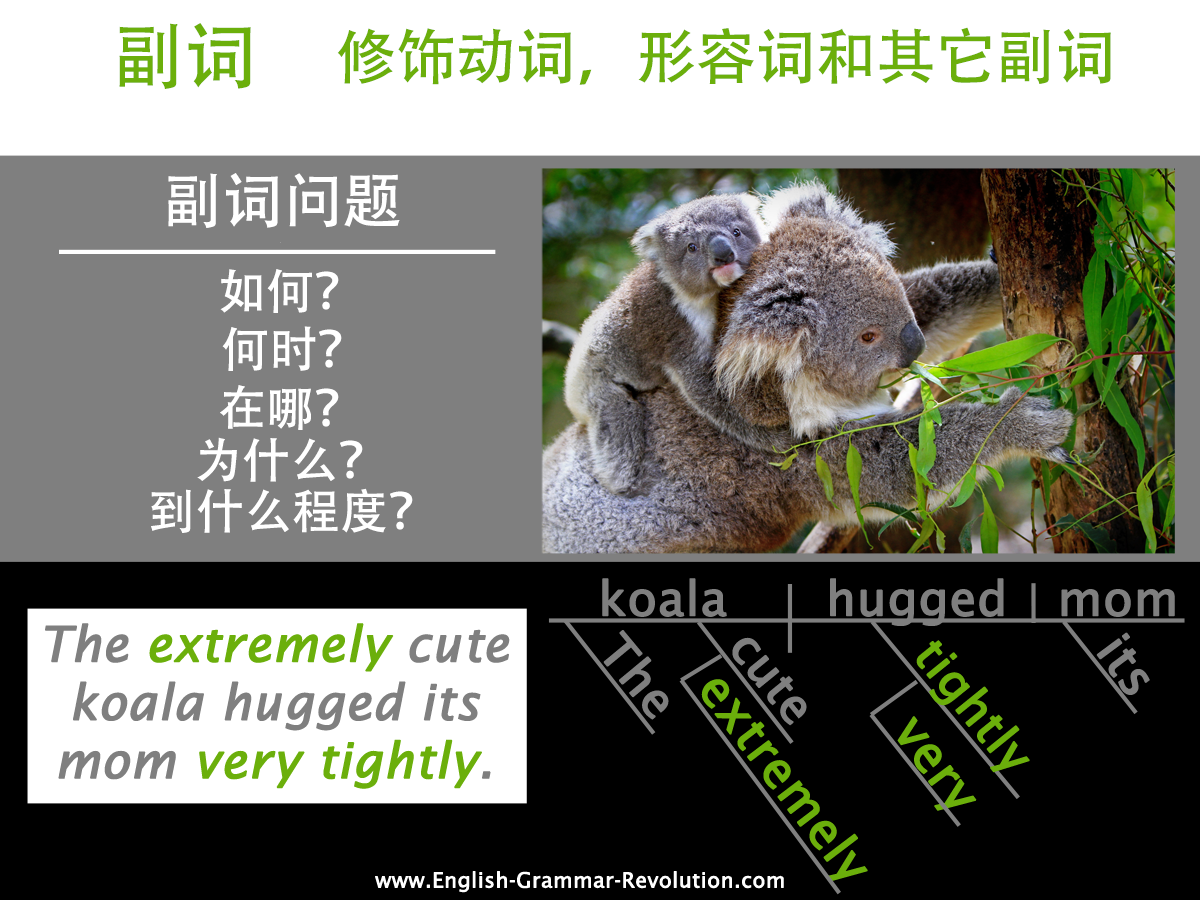
Since adverbs modify verbs, adjectives, and other adverbs, we diagram them on diagonal lines coming off of the verb, adjective, or adverb that they are modifying!
因为副词修饰动词,形容词和其他副词,所以我们在图中用斜线在被修饰的动词,形容词或副词前引入副词。
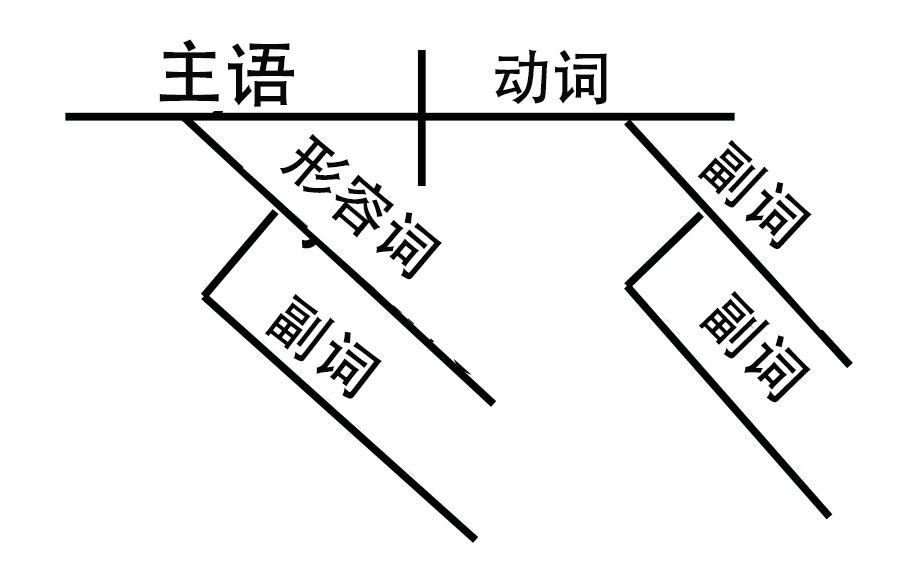
6.Prepositions show the relationship between a noun or a pronoun and some other word or element in the rest of the sentence. 介词展示了一个名词或一个代词和在剩余句子里的一些其他单词或元素的关系。
They are always in prepositional phrases (a preposition + a noun or pronoun).
他们总是有介词短语的形式(一个 介词 +一个名词或者代词)
Examples: above, behind, below, from, inside, up, over
举例: above, behind, below, from, inside, up, over
- The monkey with stripes is cute.
带斑纹的猴子很可爱。 - The frog sat in the flower.
青蛙坐在花上。
Note that prepositional phrases need to have a noun or a pronoun and that noun or pronoun may be modefied by an adjective!
注意介词短语需要有一个名词或者代词,并且名词或者代词应该被一个形容词修饰。
7.Conjunctions connect two or more words, phrases, or clauses. 连词 包含两个或更多的单词,短语或者从句。
Examples: and, but, or, so, when, because, if
例子:and, but, or, so, when, because, if
- Whenever I feel sad, I go for a walk.
无论何时我觉得难受了,我就会散会步。 - The hummingbird sat and waited.
蜂鸟坐着等。
There are different kinds of conjunctions, but they are all connectors. They are also all diagrammed on dotted lines that connect the elements they are joining.
有不同种类的连词,但他们都是连接物。在图中,他们也都用框线连接他们想加入的元素。
8.Interjections show emotion. They are not grammatically related to the rest of the sentence. 感叹词 表示情绪。他们并不是与剩下的句子有语法上的关联。
Examples:rats, gee, dam, gosh, yes, holy cow
举例:rats, gee, dam, gosh, yes, holy cow
- Oh on, we lost the game.
哦不,我们这场比赛输了。 - Wow! That jump was amazing!
哇!那一跳太惊人了!
Since interjections aren't grammatically related to the rest of the sentence, we diagram on lonely little lines that hang above the rest of the sentence.
因为感叹词并不是与剩下的句子有语法上的关联,所以我们在图中用少许独立的线条在剩下句子的上方引入这些感叹词。
Nice work!
做的不错!
Give yourself a pat on the back. You just read through all eight parts of speech. Wahoo! Would like give yourself a little quiz now?
给你自己鼓劲。你仅通读讲座的所有的8个部分。哇!现在想给自己来点测验吗?
Tiny Quiz
小测验
Directions: Identify each word's part of speech in the following sentences. Try to diagram the sentences if you can!
介绍:确定每个单词在下面句子中的词性。如果可以的话试着用图表示这些句子。
- Flowers grow.
- Sydeney has been playing
- Walter ran very quickly.
- The green box fell.
- Cathy is my mom.
- The flowers in the garden are growing.
You can use this space to write your answers, or you can write them on another sheet of paper. You'll find the answers on the next page.
你能使用这片空白来写下你的答案,或者你能把答案写在纸上的表格中。
Tiny Quiz Answers
小测验答案
Thanks for taking the time to read through this guide. I hope that you found it helpful.
非常感谢花些时间来看这个指南。我希望你觉得它有用。
If you'd like to learn (or teach) more, I'm here to help.
如果你想学习(或者教授)更多的话。我在这帮你。
www.GrammarRevolution.com
P.S. I love hearing from people, so feel free to drop me a line and let me know what you thought of this guide.
P.S. 我喜欢听人讨论,所以放心地写信给我让我知道你对这个指南的想法。
www.GrammarRevolution.com/contact.html